How to install and use a vulnerability scanner in Linux
One of the best things about Linux is the huge number of open source tools, although they may not have been installed. In this article, TipsMake.com will install OpenVas, an open source vulnerability scanning and management application, then run the first vulnerability scanning process.
You must first choose a basic Linux distribution. This tutorial will use Ubuntu. Some other distributions, such as Kali Linux, may already be installed.
In addition to installing Ubuntu, you'll need to choose which version of OpenVas will work with. Currently, there are 3 versions in circulation. This tutorial will use the latest version - Greenbone Vulnerability Management (GVM) version 10. To read more about OpenVas or GVM, you can refer to:
https://launchpad.net/~mrazavi/+archive/ubuntu/gvm Begin
To start installing the GVM, you will also need to install the appropriate mandatory repository on which the GVM depends. To do this, you'll start with opening a terminal session by pressing Ctrl + Alt + T and running the following command:
sudo add-apt-repository ppa:mrazavi/gvm The output of the above command will provide text-based instructions for the GVM, but also provide you with optional instructions.
Update Ubuntu installation
Starting with the new installation of Ubuntu 18.04, you'll want to make sure everything is up to date. To do this, run the following command:
sudo apt-get update Install OpenVas
At this point, you are ready to install the GVM. The default database used for the GVM is SQLite. If you prefer another database to use with this solution, you can find additional instructions at the link provided above.
To install GVM, run the following command:
sudo apt install gvm During the installation process, you will be prompted for additional configuration steps:
To configure Unix Socket, select 'Yes'.

To configure GVMD-sqlite, select 'Yes'.
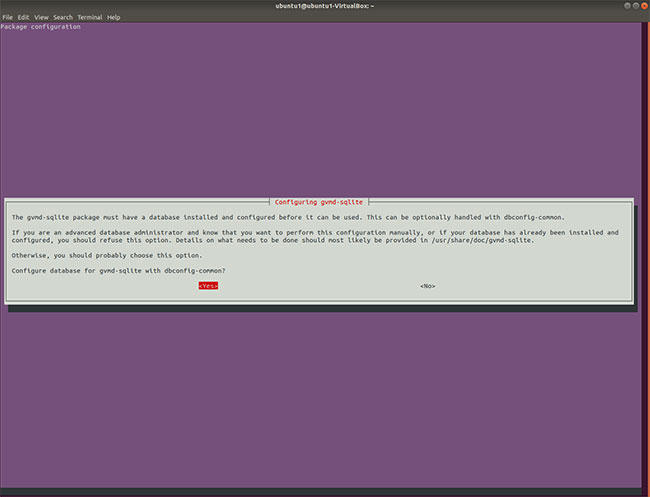
To configure GVMD-sqlite-cert, select 'Yes'.
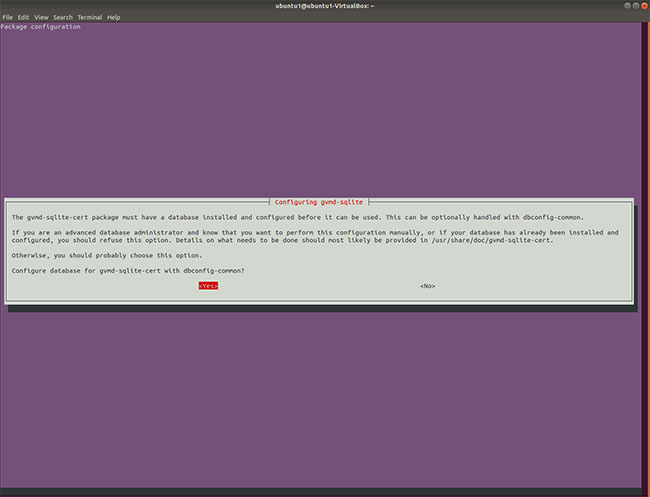
To configure GVMD-sqlite-scap, select 'Yes'.

When the installation is complete, the final step is to update the greenbone nvt / cert / scap data with the following command:
sudo greenbone-nvt-sync sudo greenbone-scapdata-sync sudo greenbone-certdata-sync Run the first scan
Congratulations on completing the GVM installation - now the fun will begin. First, check the installation status. All applications that are running properly will display a green dot (or 'active' status) when running. You can do that by launching the following items:
systemctl status gvmd # manager systemctl status openvas-scanner # scanner systemctl status gsad # web ui The GVM provides users the ability to use the Web interface. To access the Web interface, navigate the web browser to:
https://localhost:4000 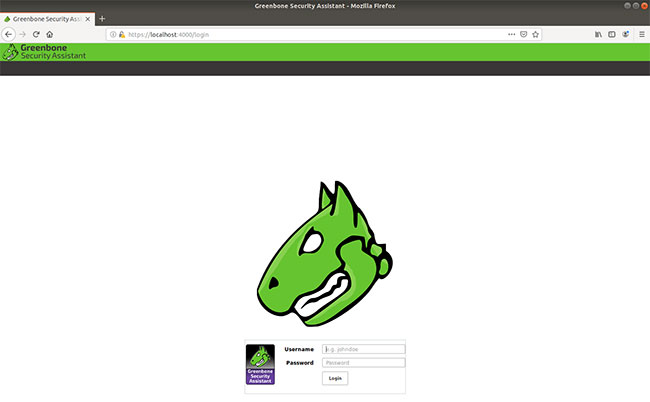
Log in with the following information:
Username: admin Password: admin After logging in with admin credentials, you can now set up the first scan. To do this, select Scan> Tasks from the application menu.
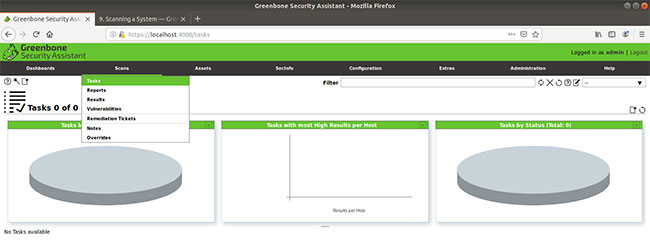
Then, from the task window, find the 'magic wand' icon and select Task Wizard .
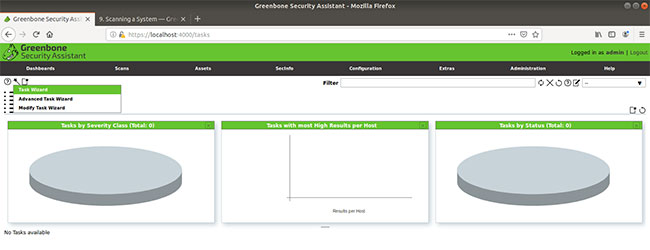
When the Task Wizard window appears, we will enter the IP address of the host. Because only one machine is used, the example will scan the local host. To do this, confirm that 127.0.0.1 has been entered. If not, manually enter the space provided.
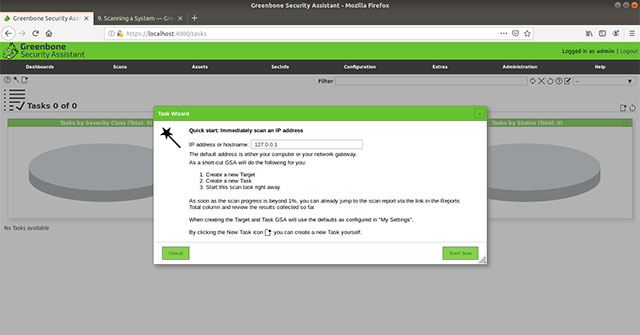
Click 'Start Scan' and wait. This may take several minutes, depending on whether you have used a new installation of Ubuntu or an existing machine.
When the scan is complete, you will see a page similar to the following message.
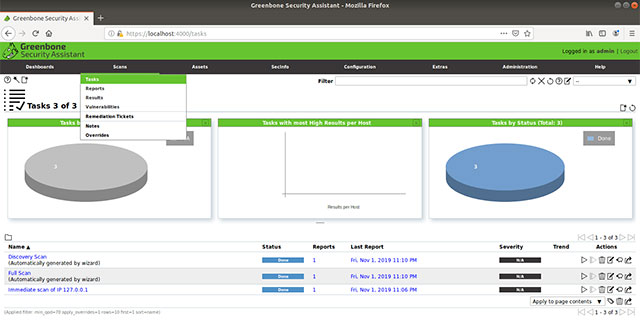
Now to see the results, go to Scans> Reports . Due to the fact that this is a new testing machine, the result was found nothing. If you run the scan on an existing machine at the company or home network, the results will be different.

These are just the tip of the iceberg about what the GVM can do to find system vulnerabilities. You can configure different scans and discover what you don't know. Sure, you will be surprised at what you will find.
Hope you are succesful.
You should read it
- 12-year vulnerability in pkexec gives hackers root privileges on Linux
- Detecting a new Linux vulnerability allows hackers to gain control of the VPN connection
- New privilege escalation vulnerability called 'Dirty Pipe' is threatening all Linux distros
- Immediately patch CWP vulnerability that allows code execution as root on Linux servers
- How to choose a scanner
- 4 best barcode scanning apps for Android
- How to install Canon Lide 120 scanner
- How to install and use the scanner
May be interested
- How to install Solus Linux
 recently, the linux community has given winged compliments to solus linux. this is understandable because this is a beautiful operating system with lots of great features. in a world where most popular linux distributions are 'derivative ubuntu', solus linux really stands out.
recently, the linux community has given winged compliments to solus linux. this is understandable because this is a beautiful operating system with lots of great features. in a world where most popular linux distributions are 'derivative ubuntu', solus linux really stands out. - 5 reasons to install Linux on old computers
 a lot of people like to use linux on older machines. everyone has a different reason. some people may want to save money by not upgrading to a new computer, while others may want to avoid wasting usable electronics.
a lot of people like to use linux on older machines. everyone has a different reason. some people may want to save money by not upgrading to a new computer, while others may want to avoid wasting usable electronics. - How to install Kali Linux on macOS
 since the release of kali linux 1.0.8, kali linux supports efi. this additional feature simplifies the process of installing and running potassium on various apple macbook air, pro and retina models.
since the release of kali linux 1.0.8, kali linux supports efi. this additional feature simplifies the process of installing and running potassium on various apple macbook air, pro and retina models. - Steps to install Webex for Linux
 webex is now available for linux. linux communities and users can use webex to bring you live messaging, meetings, and calling in work and education environments.
webex is now available for linux. linux communities and users can use webex to bring you live messaging, meetings, and calling in work and education environments. - How to install NVIDIA drivers on Kali Linux
 this document explains how to install nvidia drivers on kali linux and supports cuda, allowing integration with popular intrusion testing tools.
this document explains how to install nvidia drivers on kali linux and supports cuda, allowing integration with popular intrusion testing tools. - How to install Kali Linux on Android using Linux Deploy
 installing kali linux on android devices is no longer a difficult job thanks to the linux deploy tool. read the following article to learn how to do it.
installing kali linux on android devices is no longer a difficult job thanks to the linux deploy tool. read the following article to learn how to do it. - How to install Windows Game on Linux with Winepak
 flatpak is a favorite choice of third-party vendors and proprietary software developers because it allows them to package linux programs once and distribute them on all linux versions.
flatpak is a favorite choice of third-party vendors and proprietary software developers because it allows them to package linux programs once and distribute them on all linux versions. - Instructions for installing basic Arch Linux
 unlike ubuntu or linux mint, arch linux is a distributed linux distribution in a continuous format (rolling release). read the following article to know how to install this distro.
unlike ubuntu or linux mint, arch linux is a distributed linux distribution in a continuous format (rolling release). read the following article to know how to install this distro. - How to install Kali Linux on your computer
 installing kali linux on your computer is an easy process. first, you will need compatible hardware for computers. kali is supported on i386, amd64 and arm platforms (both armel and armhf).
installing kali linux on your computer is an easy process. first, you will need compatible hardware for computers. kali is supported on i386, amd64 and arm platforms (both armel and armhf). - How to install Spotify on Linux
 spotify has actually supported linux for a long time. although most distributions do not include this application in the repository for license reasons, it is not really difficult to install this official player on a linux pc.
spotify has actually supported linux for a long time. although most distributions do not include this application in the repository for license reasons, it is not really difficult to install this official player on a linux pc.










 11 df commands in Linux (with example)
11 df commands in Linux (with example) Minimum hardware requirements for installing FreeBSD
Minimum hardware requirements for installing FreeBSD How to add simple launcher dashboard on LXDE
How to add simple launcher dashboard on LXDE How to perform graphical stress test on Linux
How to perform graphical stress test on Linux How to search Google everything with Clipman in Linux
How to search Google everything with Clipman in Linux Learn about Ubuntu Remote Desktop
Learn about Ubuntu Remote Desktop